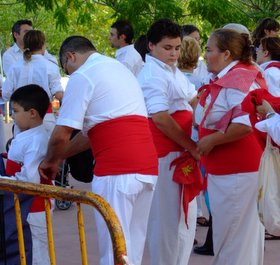
I feel as if I’ve just been let into the most wonderful secret. I have spent the last week in the wine producing areas of Priorat and Montsant in Catalonia in Spain.
All I knew about Spanish wine amounted to two words, Rioja and Cava. Then I read that Robert Parker had awarded wines from the Priorat marks in the high nineties and, as I was going that way anyway, it seemed like too good a chance to miss.
I’m not even going to pretend that I know a lot about wine. But it’s always interesting to see what your palate tells you about something you know nothing about.
The Priorat is a small DOQ region, surrounded by the crescent of the larger DO region of Montsant. Both are inland from Tarragona, south of Barcelona.  The Priorat, which gets its name from the priory or monastery of the Carthusians at Scala Dei in the north of the region, is a land of harsh and beautiful mountain landscapes, of vines and olive trees, and a slate soil called ‘licorello’. Montsant has a greater soil diversity and its vines are allowed to produce a greater quantity of grapes. In Priorat sometimes only one kilo per vine is permitted, concentrating the flavour into powerful wines. The grapes are the traditional cariñena and garnacha, but now with quantities of syrah and merlot for structure. Anyone interested in learning more will find this article by Gerry Dawes extremely interesting.
The Priorat, which gets its name from the priory or monastery of the Carthusians at Scala Dei in the north of the region, is a land of harsh and beautiful mountain landscapes, of vines and olive trees, and a slate soil called ‘licorello’. Montsant has a greater soil diversity and its vines are allowed to produce a greater quantity of grapes. In Priorat sometimes only one kilo per vine is permitted, concentrating the flavour into powerful wines. The grapes are the traditional cariñena and garnacha, but now with quantities of syrah and merlot for structure. Anyone interested in learning more will find this article by Gerry Dawes extremely interesting.
The centre of Priorat production is the hilltop village of Gratallops, and, as luck would have it, there is a really good restaurant there, Los Irreductibles.
 The kitchen is presided over by Ricardo Signore and the influence of Ferran Adria is evident throughout the menu. What is also great about this restaurant is that, firstly, there is no choice, you get what Ricardo has decided to cook. And secondly you can ask him to let you drink wine by the glass instead of having to order a bottle. So you get a glass of what he thinks will go best with what he has decided to cook. And when that is monkfish with fig confiture, or fillet of beef with foie gras and coffee, it is good to have someone else do the choosing! I think my favourite dish was a rich chocolate dessert with a coconut cream sauce and curry foam. The scent of the curry with the chocolate was wonderful.
The kitchen is presided over by Ricardo Signore and the influence of Ferran Adria is evident throughout the menu. What is also great about this restaurant is that, firstly, there is no choice, you get what Ricardo has decided to cook. And secondly you can ask him to let you drink wine by the glass instead of having to order a bottle. So you get a glass of what he thinks will go best with what he has decided to cook. And when that is monkfish with fig confiture, or fillet of beef with foie gras and coffee, it is good to have someone else do the choosing! I think my favourite dish was a rich chocolate dessert with a coconut cream sauce and curry foam. The scent of the curry with the chocolate was wonderful.
Wine business is done in Falset, a busy little town on the main road to Reus. Wine people gather in the restaurants of El Cairat, El Celler de L’Aspic, Hostal de Sport and Mas Trucafort for Catalan specialities and more great wine.
 South of Falset is one of the Montsant co-operatives at Els Guiamets, where the young winemaker, Eugenia Guasch, speaks excellent English and will show you round her Celler. The grapes were coming in the door in trailer loads as we talked. Montsant is a very young DO which already shows great promise, although it does not have the grandness, or the punch, of its stately neighbour in Priorat. The winemakers are young and enthusiastic and, typically, Eugenia’s top red wine, Isis, has a label designed by the current architect of the Sagrada Familia in Barcelona, and a strangely shaped bottle with a sloping back.
South of Falset is one of the Montsant co-operatives at Els Guiamets, where the young winemaker, Eugenia Guasch, speaks excellent English and will show you round her Celler. The grapes were coming in the door in trailer loads as we talked. Montsant is a very young DO which already shows great promise, although it does not have the grandness, or the punch, of its stately neighbour in Priorat. The winemakers are young and enthusiastic and, typically, Eugenia’s top red wine, Isis, has a label designed by the current architect of the Sagrada Familia in Barcelona, and a strangely shaped bottle with a sloping back.
Most of the wine in both regions is red; the Priorat produces wines with tremendous concentration and power, redolent of wild black fruits, licorice and herbs. And they command high prices. The wines of Alvaro Palacios were on the restaurant menus for over €300, and fetch astronomical prices elsewhere. A big discussion is going on about the use of oak, and most of the good producers are cutting down on it. One of the ways they temper the new oak is by using it for their second wines, and also for the small amount of white wine produced. This gives the ordinary white wines a strong oaky taste, ok with food but a bit much without!
To the north of the region the mountains rise steeply; to the south the river Ebro marks the western edge and over to the east the region of the Penedes starts, with its massive Cava production.
And that’s where the blog went next, not to drink Cava, but to see something quite unique…

 There are apartments and houses to rent that can be found on the internet, but to be honest I found that many of the enquiries I made met with silence, even though I did write in Spanish. I was, therefore, delighted to discover Mike and Bev Powell, who were the first English people in Mora D'Ebre and have acommodation to let. Mora D'Ebre itself is a busy little place with an old part of town near the river. We stayed in Mike and Bev's house there and it was quiet and well set out, with good accommodation for up to four people in two bedrooms, and a sofa bed as well. Mora D'Ebre is in a very good location for the wine regions, for amazing castles and views (see above) and for the coast, as well as the extraordinary delta region of the Ebre river, where the main crop is rice.
There are apartments and houses to rent that can be found on the internet, but to be honest I found that many of the enquiries I made met with silence, even though I did write in Spanish. I was, therefore, delighted to discover Mike and Bev Powell, who were the first English people in Mora D'Ebre and have acommodation to let. Mora D'Ebre itself is a busy little place with an old part of town near the river. We stayed in Mike and Bev's house there and it was quiet and well set out, with good accommodation for up to four people in two bedrooms, and a sofa bed as well. Mora D'Ebre is in a very good location for the wine regions, for amazing castles and views (see above) and for the coast, as well as the extraordinary delta region of the Ebre river, where the main crop is rice.












